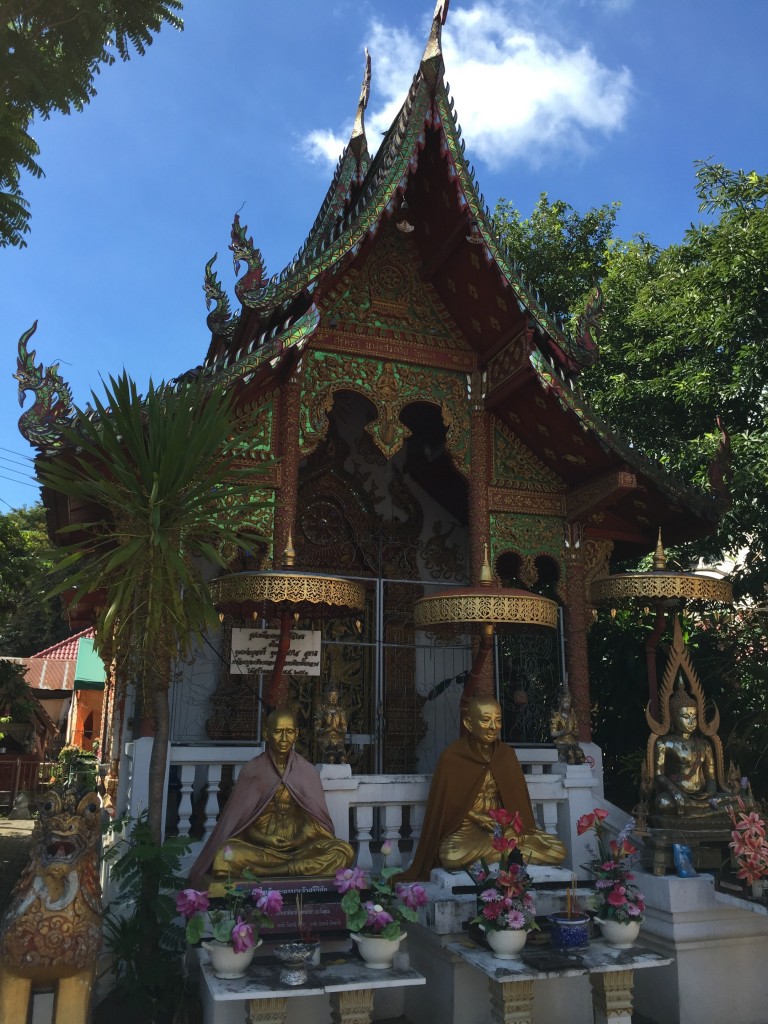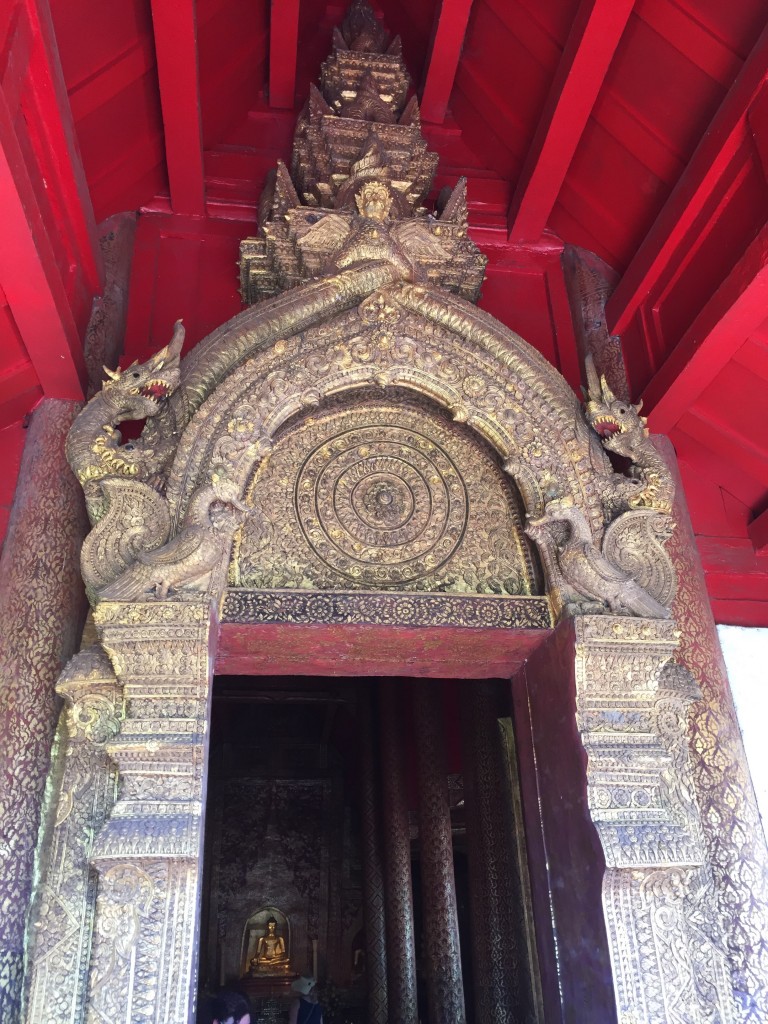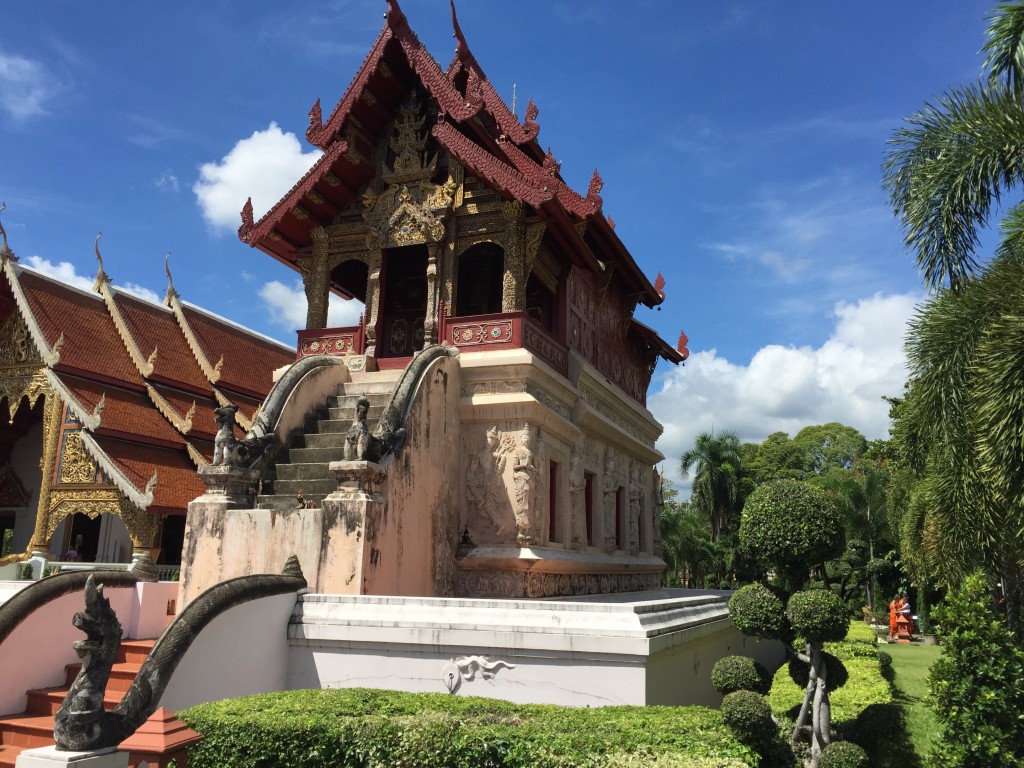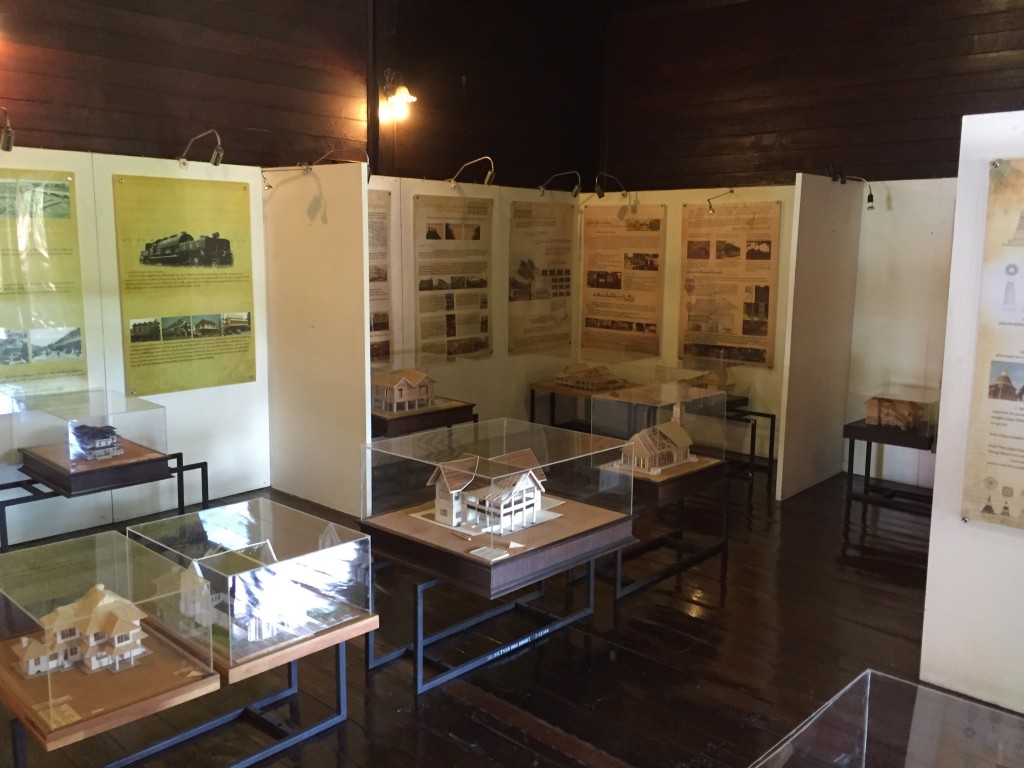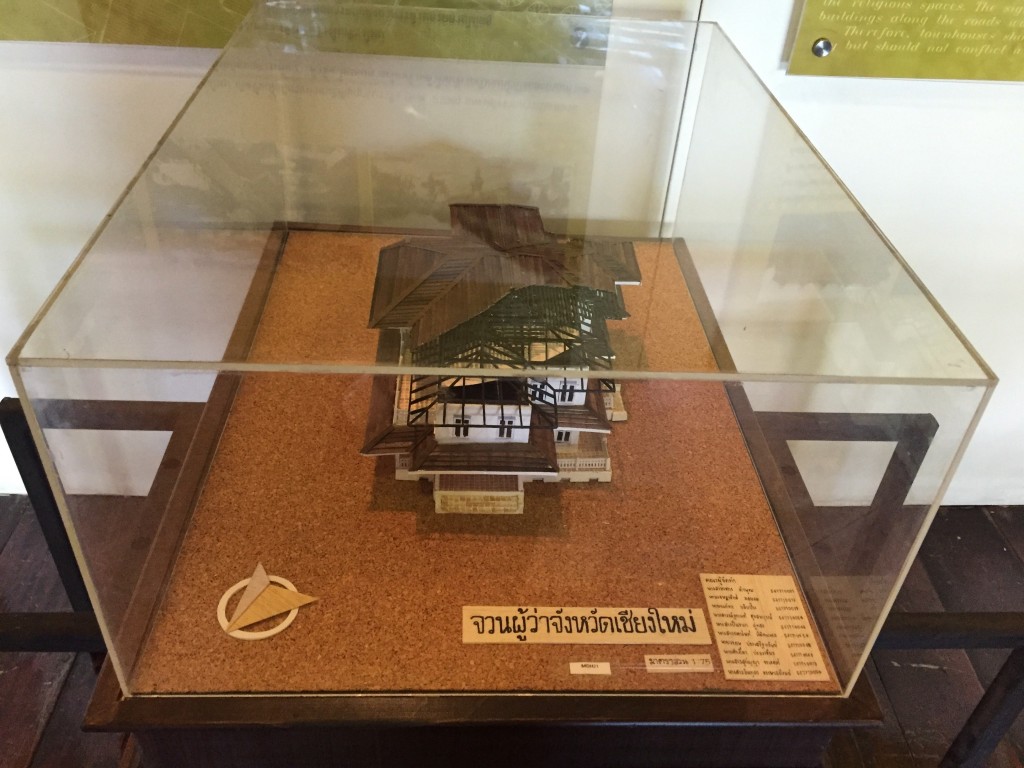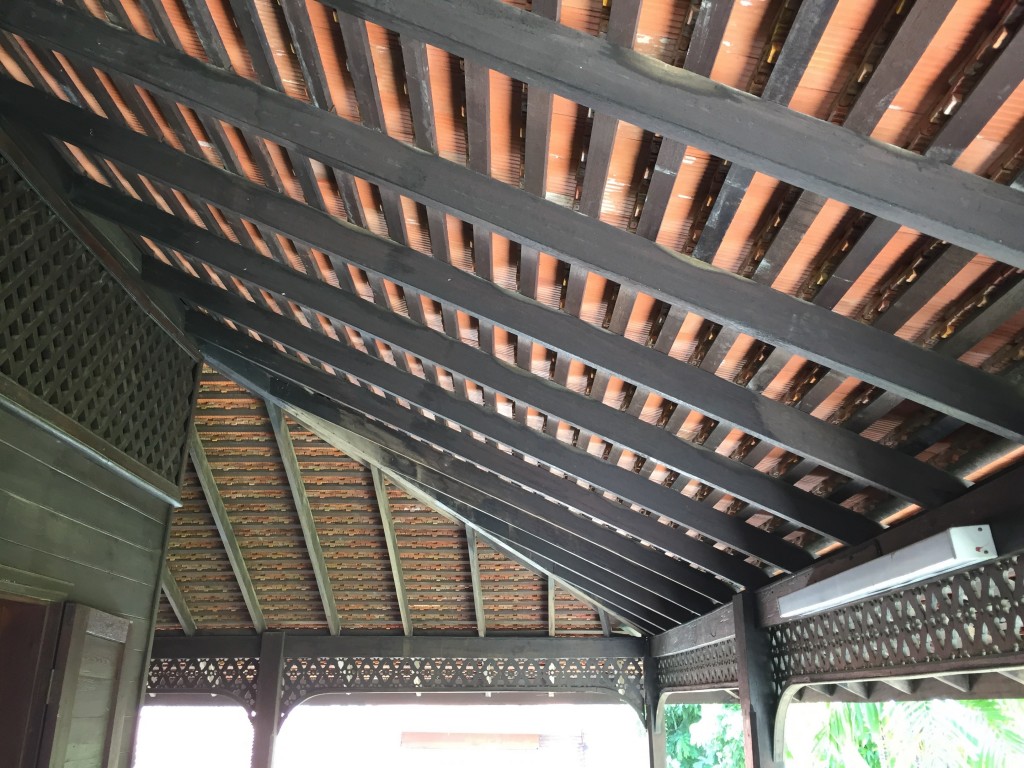You know, Dickens was a hell of a writer, but lumping both of those cities’ tales into 1 book was just bad planning. He should have put the first city in one book, broke it at a cliffhanger, and then stretched the second city out into a popular sequel. Boom, instant money. I’m sure in the Peter Jackson version this will be corrected, perhaps enhanced into 4 movies, with special appearances by Queen Victoria and a CG Spanish Armada, with Andy Serkus providing the motion capture performance of his career as the mad aristocratic twins Jean/Jeanette, first victims of Monsieur Guillotine:
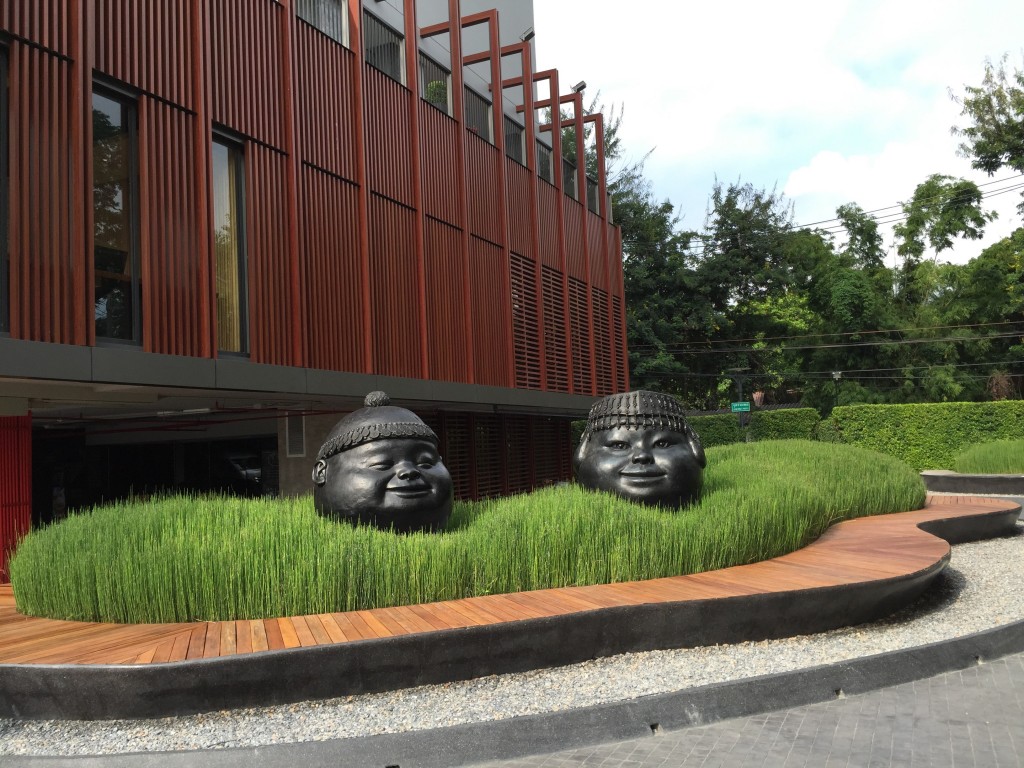
“But Jean, ow will we have our croissants with eavy cream?” “Do not worry, Jeanette, our mouths have not been harmed by ze wicked blade of La Révolution!”
Wednesday, October 7th
The next walking tour happened on Wednesday, October 7th, 10 days after the last one. This time, it was a tour of the Old City, which was exactly the same walking tour I’d tried to take with Tony last February, when Google directed me to someplace completely different than the actual meeting place and I’d had to cancel. This time, that wasn’t a problem. The Airbnb map had an accurate pointer to the place, and now I’d been there before. It was a cafe in a Non Buak Hard Public Park (it didn’t look terribly hard, but I may have been missing something) just inside the moat of the Old City, in the southwestern corner. We hung out there for about 1/2 an hour waiting for everyone to arrive, which seems to be a recurring theme on these trips. (In fairness, I was probably that guy being waited for last time. I’d assumed everyone had simply gone on without me, but at least I sent a text as soon as I knew I wouldn’t make it in time.)
I think a few of the “regulars” didn’t come to this one because it was a repeat, and I know a couple of folks didn’t come because it was a weekday. (It was a school holiday, so Tony had the day off from his usual university teaching gig.) This time, we had MJ, a short, stout, British lady older than I was (who looked like she’d been quite the pixie when she was younger), who I feel like was maybe a nurse, and who took in foster kids. She was here on vacation (between kids, I guess). And Claudia, a tallish American woman, also older, whose husband had been a physicist until he’d been laid off and decided to take up woodworking as a profession. (When science doesn’t give you wood anymore, I guess you’ve got to find it somewhere else.) They lived in San Diego, and she was on her way to a 2-week meditation retreat in Koh Samui (the island I spent 10 weeks on). She was rather the image of upper middle class New Agey lady and hosted weekly gatherings of people who did New Agey things, like share new meditations, or ask each other “What’s Next?” for no particular reason.
Joining us 1/2 an hour late was her friend, Mark, the reason she was in Chiang Mai; he traveled, and whenever they (and her husband, normally) were in the same place they’d hang out. Mark was probably mid-50s, lean, weathered, balding, very hairy, and very American, with a friendly, forceful voice and aggressively healthy lifestyle. I think his last name must start with “M” also, since I heard him introducing himself to the British lady as, “M&M, melts in your mouth, not in your hand!”, with a loud sort of bonhomie, earning my instant dislike (though that faded quickly enough, and he ended up seeming a decent enough sort). He was in Chiang Mai to start some sort of Vegan food business, that he’d transfer to the states once he got it running. I didn’t grill him too closely on this, because I didn’t want my skepticism to put any kind of damper on someone actually creating a new business (tough enough, without random strangers looking suspicious about it). And then David, a French guy in his 20s who’d decided to live in Chiang Mai, had just recently arrived, and was going to be looking for work here.
(If I’m spending a lot of time talking about the people I’m touring with, please don’t think that I’m going soft. It’s just that, well, the rest of this is a lot of trees, temples, amusing signs, the usual, and it’s the people that are standing out more. I’ll be back to my usual disdain very shortly.)
So we started at the southwest corner of the Old City which, like the other corners, has a bit of the old wall left:
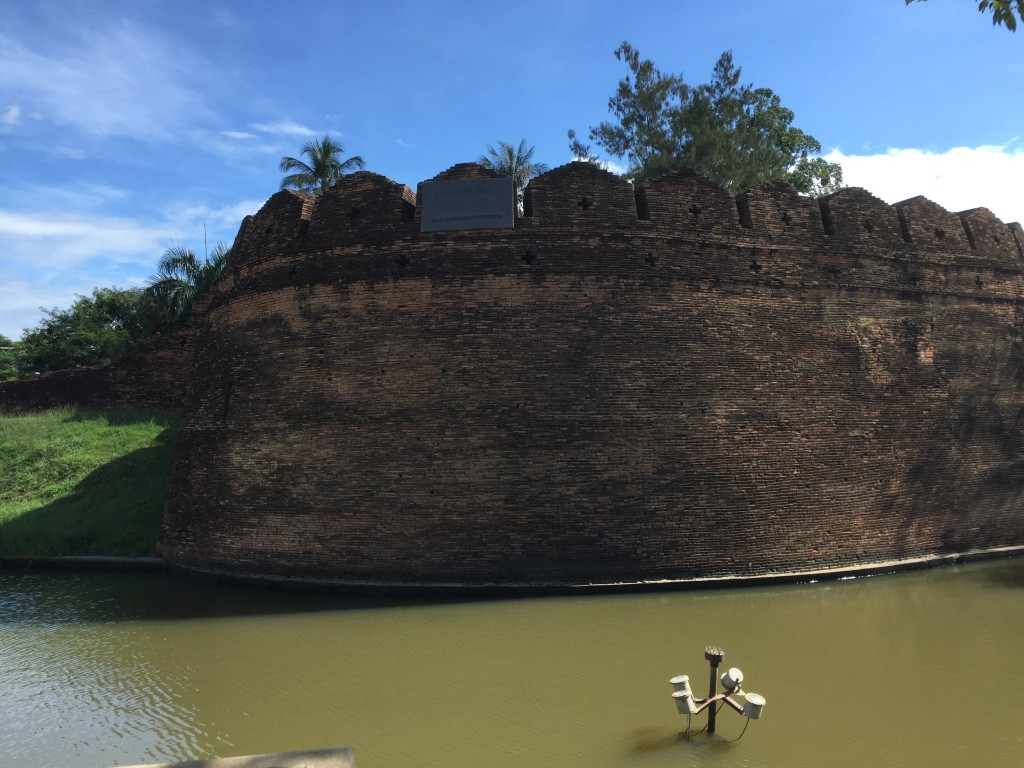
As the plaque describes, this is known as Ku Huang Corner. What it probably glosses over, is that it was named after the warden of the prison that used to stand here. Apparently he was a very popular prison warden — popular to the sorts of people who get to name parts of the city, at any rate.
Then we crossed the Loop of Death to the park just south of that southwest corner:
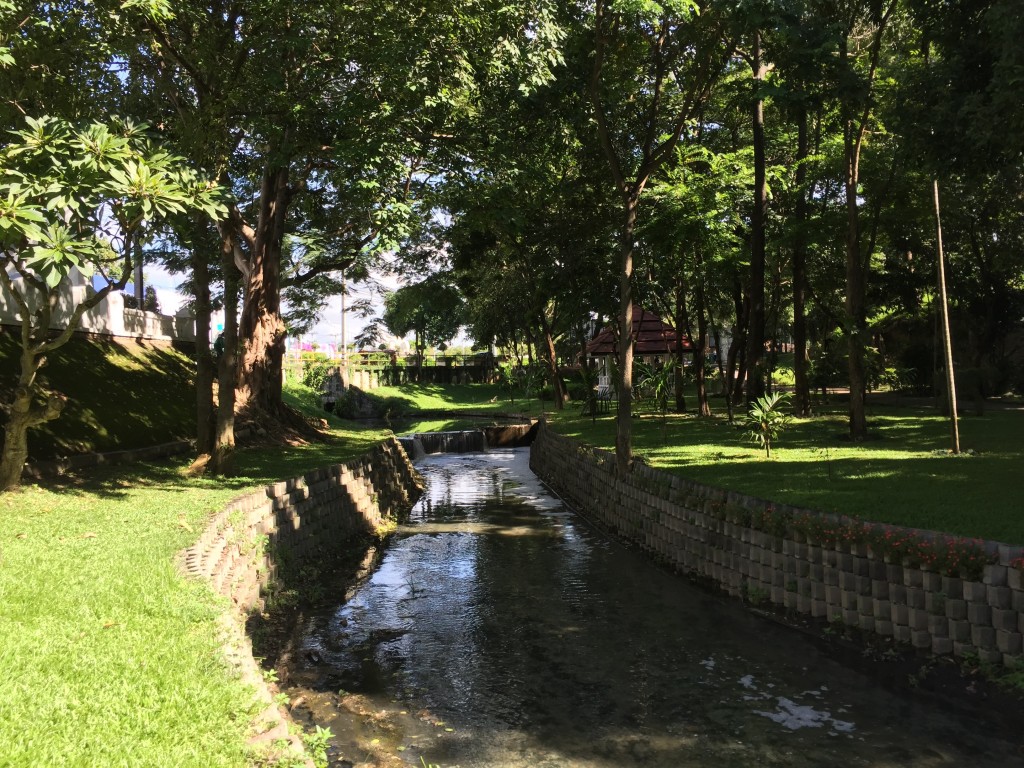
I title this picture, “Pretty Park is Pretty, #73 in a series”. The small park is right next to the Loop of Death and the road that runs southward out of it, and it gets a bit too much traffic noise and exhaust for me to want to hang out in (as is true of many of Chiang Mai’s central parks). But it’s got “pretty” taped.
The southwest corner of the city is pretty enough, but Tony says that it’s the southeast corner where all the fishing happens. That’s not really a tourist attraction for me, so I’ll have to take his word for it. He says that they made fishing on the moat illegal, but people still do it, at night, when the cops aren’t looking. (No different from illicit moat fishing anywhere, I suppose.)
Then we crossed back across the Loop of Death — Tony, by the way, says the key to crossing it is to make eye contact with the driver. But this relies on too many moving parts for my taste (the car, the driver, me, my blood and guts potentially traveling at greater than normal velocities in different and undesirable directions), and probably works best when you and the driver share a cultural mindset and body language. Me, I’d rather wait patiently for a suitable gap and then run like hell.
We wandered up the west side of the moat (which forms the median strip of the Loop of Death), passing a local high school that had a walkway built over the road (lucky bastards), and paused to note a fruit tree growing beside the moat, with small orange fruits that looked like tiny loquats. Tony said that they were edible, and ate one to prove it, so I did the same — a mistake I sorely regretted. The one thing you can usually count on in a fruit is moisture, but this was like a decorative berry made of sawdust. It not only sucked all the water from my mouth and left dry gritty particles there for the next ten minutes, its remains lodged in my throat on the way down and flatly refused to continue their proper journey for the next 2 hours — with me swallowing and reswallowing and throat clearing, and discretely coughing and hacking — until we stopped for a snack and I was able to push them down with iced coffee and oatmeal cookie. Even then, my throat was uncomfortable for the rest of the day. It was miserable. I wish I knew what sort of fruit it was, but I’m not sure that Tony ever named it — and it’s hard to magically curse something to grow barren and die when you don’t know its true name.
From there we wandered back across the Loop, again, to get to the inside of the Old City, and headed to our first temple, which I cannot for the life of me find the name of. I can even find Chaing Mai tourist maps in Google Images, that show little “temple” symbols for its location (which marked by a little star just inside the western wall in my map above), but nothing that actually names it. Ah well. The buildings had a nice shade of green, and I guess that’s enough.

Wat Green Temple had several buildings with this green tint, which I haven’t seen at any of the other temples.
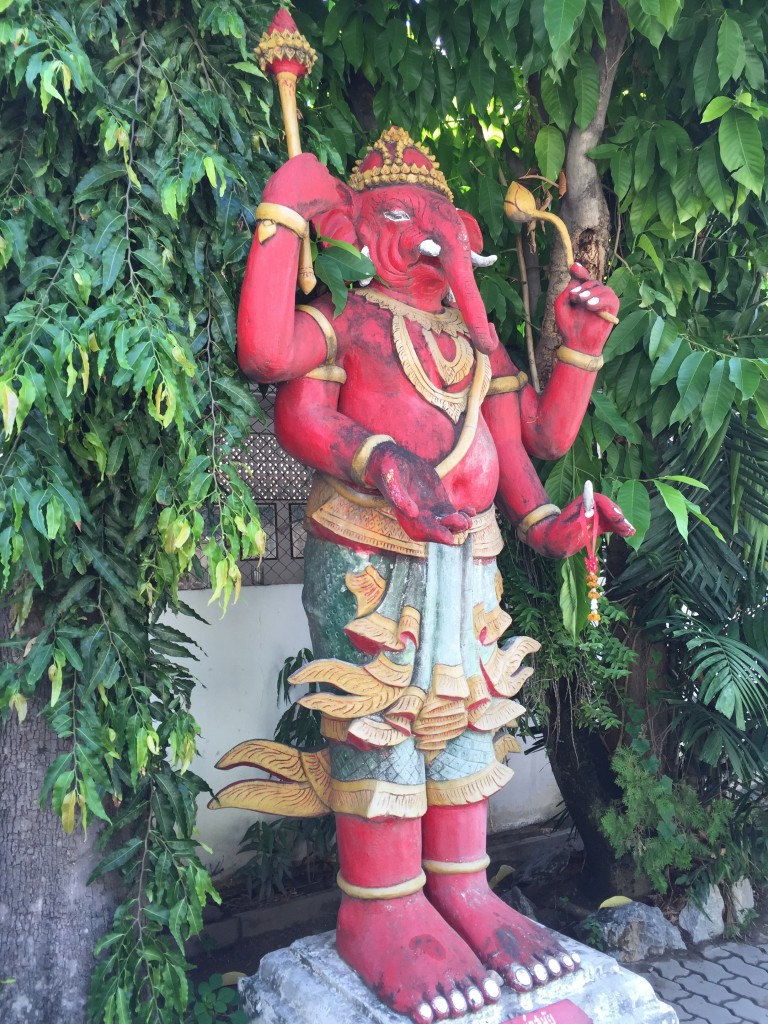
Hobbit Ganesha needs a bath. Seriously, Thai people, would it kill you to keep your buildings and statues clean? This is a god, you know.
I feel like we hit another temple that I have no pictures of, because (a) I vaguely remember one, and (b) there’s a little star on my map that the route I drew passes by. I’ve started making a point of using my iPhone’s Google Maps to save a star at each place we stop on these tours, so that I can spot them more clearly later. I think that we actually walked through some small temple grounds, but I’m guessing the buildings must have been pretty much business as usual and we didn’t spend much time there. A bit dismissive of me, really — there are probably monks who make that place their whole lives — but when the online maps don’t mention it what can you do? I’ll try to take better notes next time.
From there we walked to Wat Chedi Luang, probably the main temple complex of the Old City. I’d been to WCL a couple of times when I was here in the spring (like, in this post, towards the end of my Night Market trip), but we spent a bit more time in it than I had before.
The building on the left here is a pretty normal temple design, though it has nice dragons outside, and Tony made a big point of how great the architecture was, and how the horns at the roof peak line up perfectly when viewed from the front. I thought that they were very slightly off, myself, but maybe they line up perfectly when you come from a culture that doesn’t feel the need to keep its gods and dragons clean.
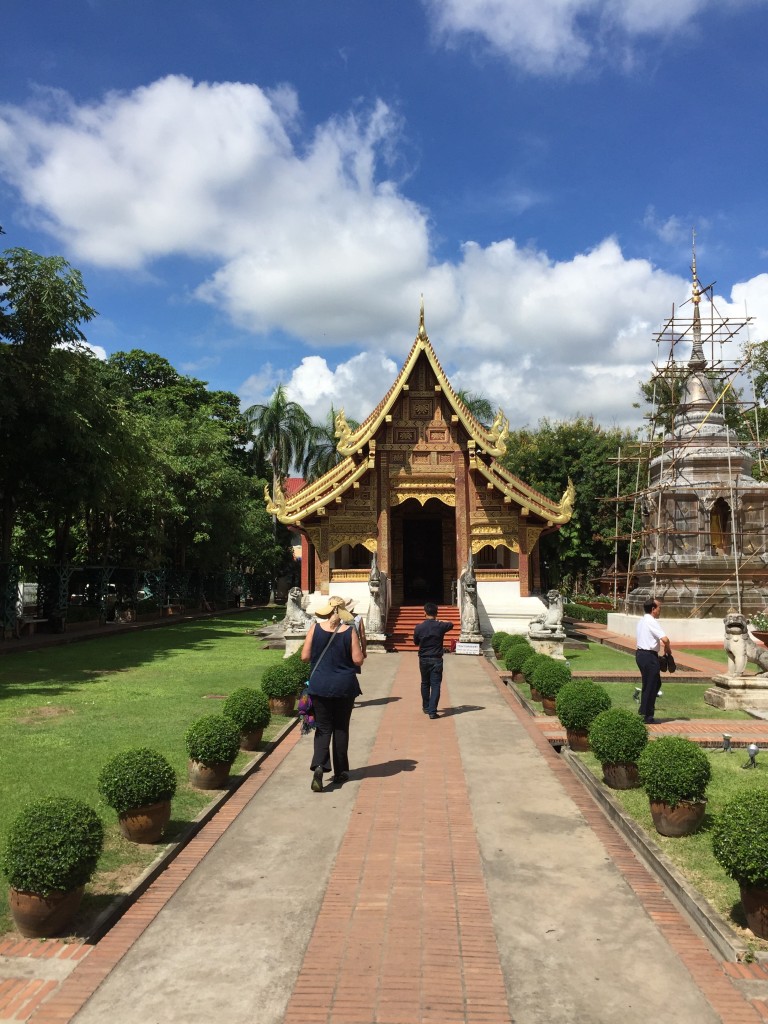
In fairness, the picture that I took from the front makes them look pretty well aligned. I feel that this was a failure of the iPhone camera — it can’t even focus on the moon at night, so I shouldn’t expect too much from it.

The interior of the temple; the murals could do with some restoration, but the gold is holding up pretty well. (That’s David standing, with Claudia on the left and Mark on the right, both seated.)
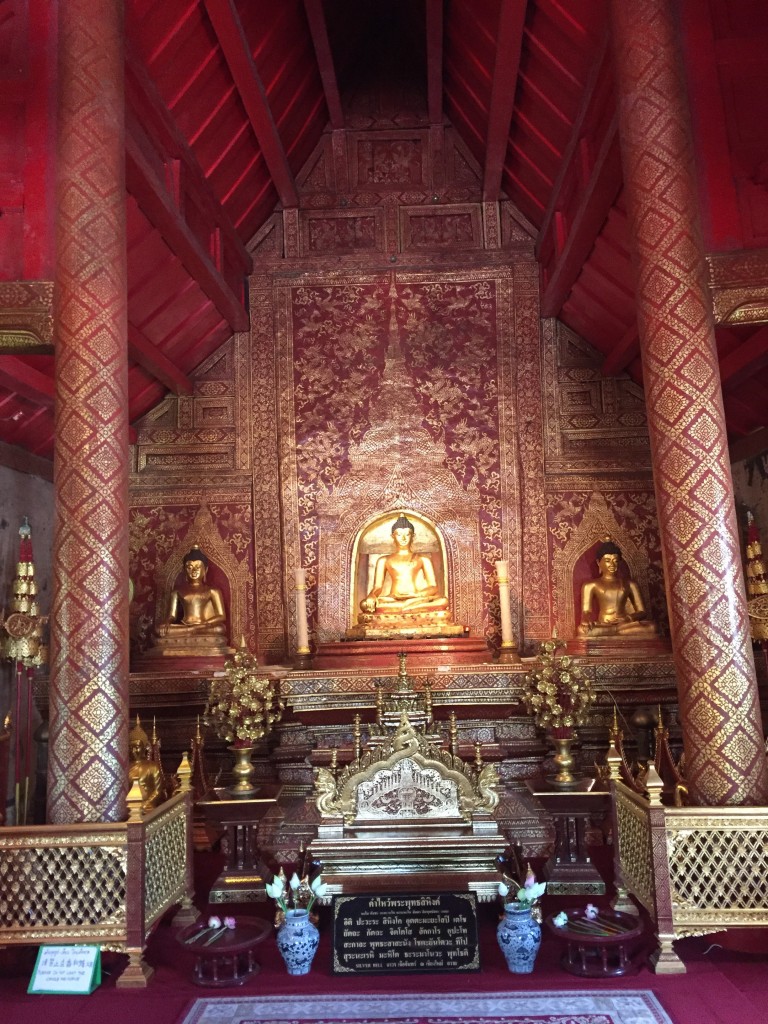
This center gold Buddha is the primary Buddha statue of Chiang Mai, and is brought out on parade once a year. It is, admittedly, a very nice Buddha.
The next building was also pretty snazzy, and had nice things in it also.
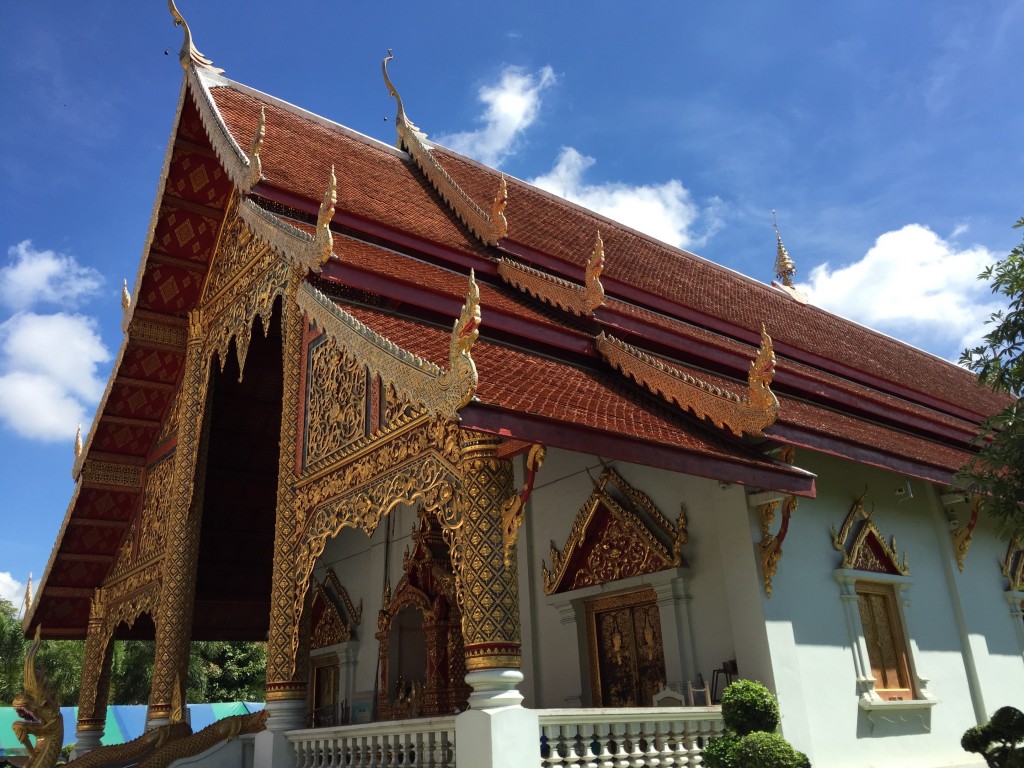
One thing that keeps striking me as odd about Thai temples is that parts are ornate, and other parts aren’t. Like, OMG the gold detail on the balcony supports. Or on the window caps, or the corners of the roof. And then they come to the wall and go, “Meh, white spackle should do it.” It’s a different aesthetic taste than you see in the west — if we had that level of detail on the front of a temple, we’d keep it up all the way around. It would be gaudy, but by gods we’d do it.
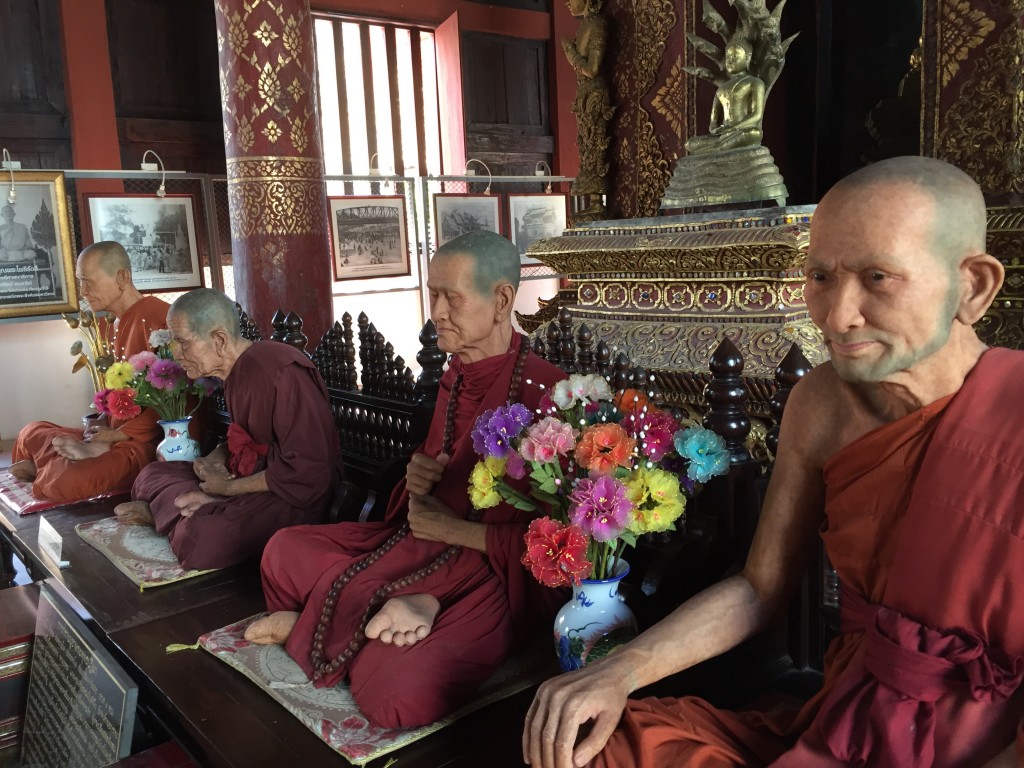
It’s the next advance in Buddhist theory: you don’t have to achieve emptiness when you start with an empty monk. I feel weirdly like the monk in the foreground looks like me. Don’t know that he really does, but there’s something about him….
This building had some exhibits about the city’s and the temple’s history. The one I found most interesting was:
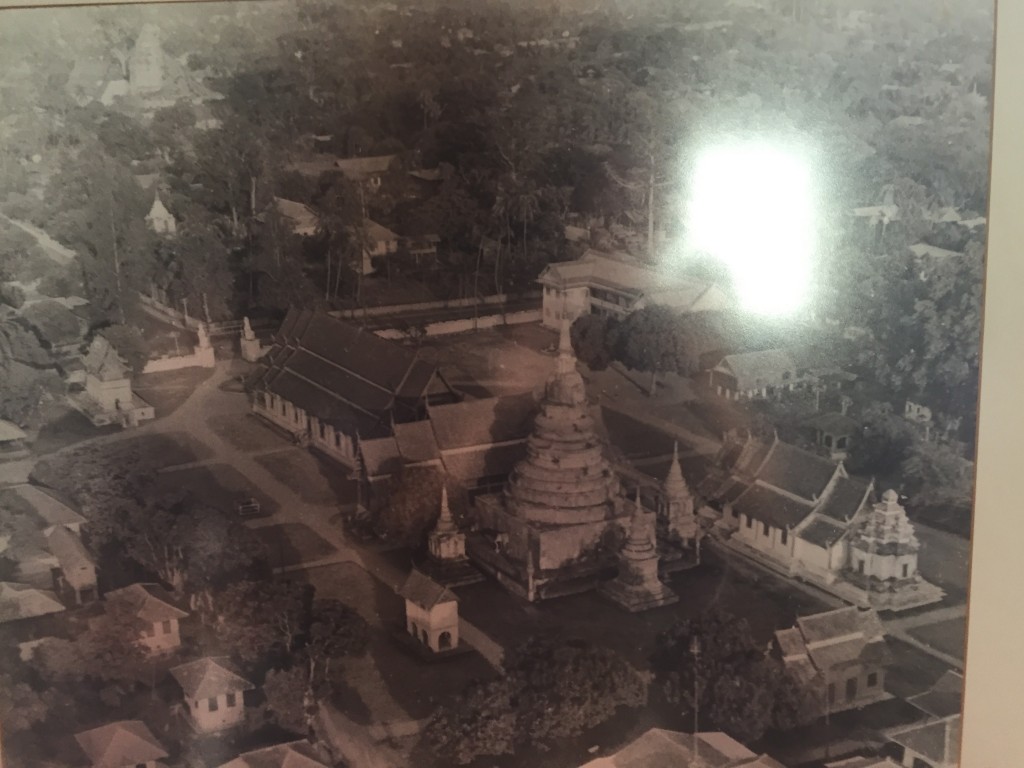
The Old Old City, circa around 1950ish. Walking around the Old City today, I thought all the buildings were oldish, but it looks like they’re merely rundown (big surprise). Go back a few decades, and the place wasn’t nearly so built up.
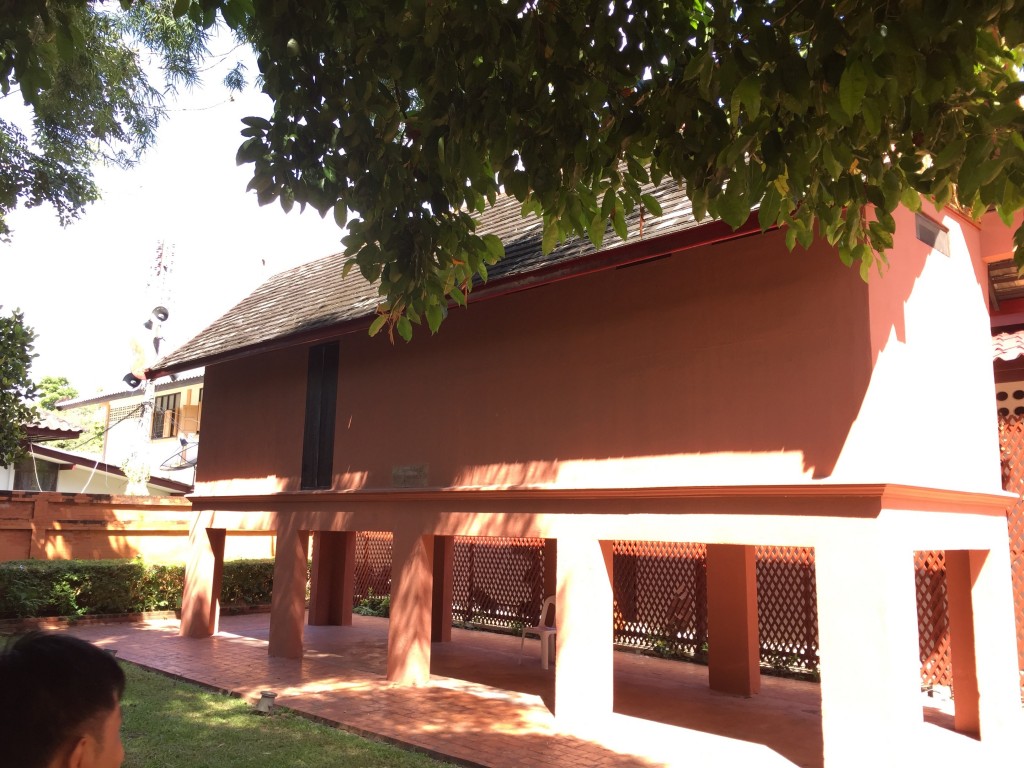
We couldn’t guess what this curious building was. Tony explained that the temple’s head monk had been getting so many interruptions, he couldn’t meditate. So he had this building built: he would put a ladder up to the door, climb up into the building, pull the ladder up after him, and then do walking meditation until he was done. No interruptions that way. It’s good to be the head monk.
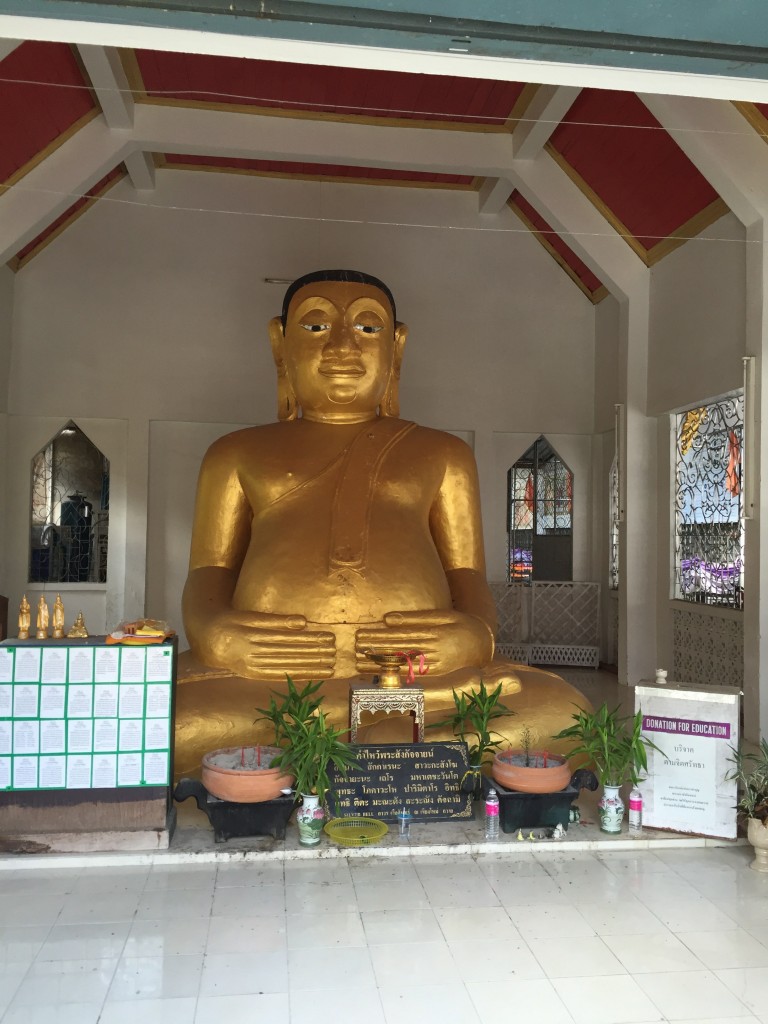
Fat Buddha. The Thais once believed that the mind resided in the stomach, so a fat Buddha indicates intelligence. (Unlike China, where it would indicate prosperity.) Expectant mothers come to this Buddha to pray for intelligent children, and Tony’s mom had done that. I resisted the urge to ask him if it worked. (And, truthfully, it seems to have.)
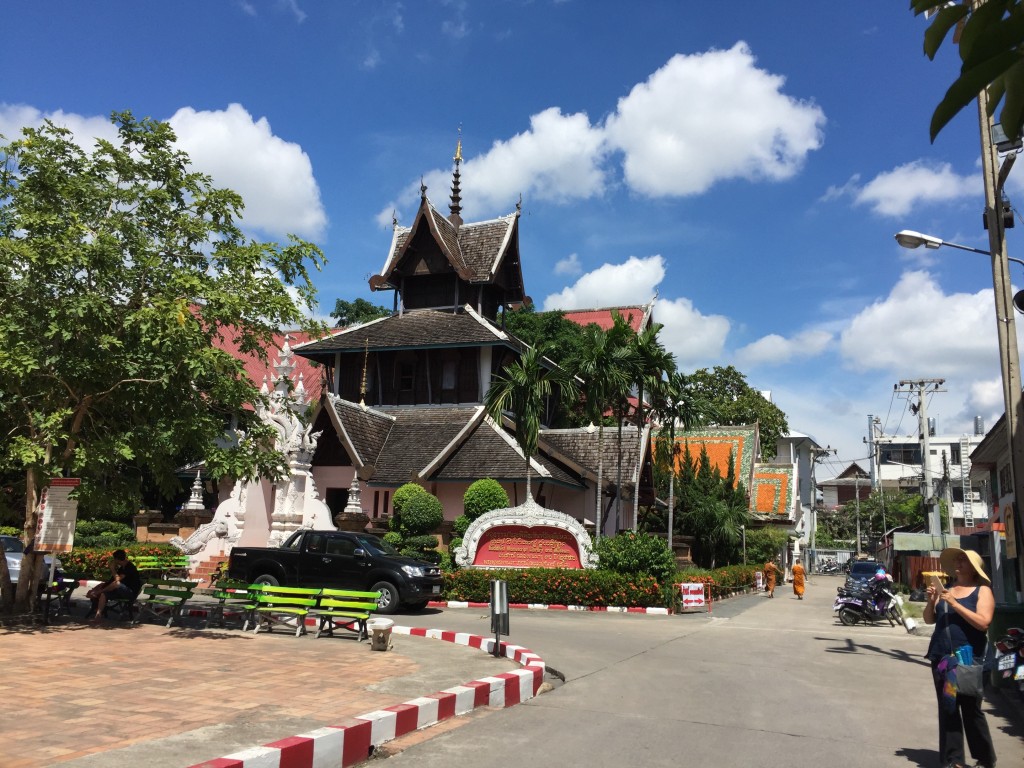
Random building that I’m pretty sure is not a temple. Probably an administrative building. I mean, come on, it only has one ornate archway, and no gold at all! Anything that dull looking is probably involved in accounting.

I guess the reason Thais don’t maintain their buildings is they figure, if they wait long enough, they’ll become historic. It certainly works for some of them.

You look like a man who wants a chariot of the gods. And you’re in luck, the new 5017 models have just arrived! Please, come into our show room.
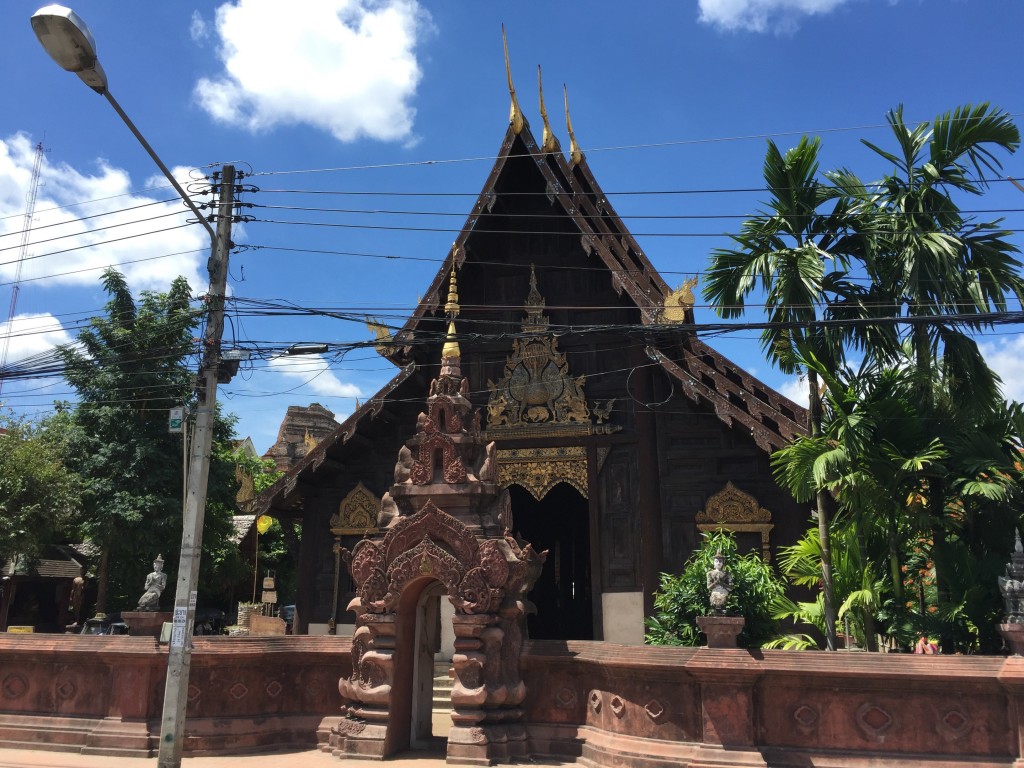
I have to confess, I prefer the earth tones over the white plaster of the main temple buildings. Also, I wonder if those spires function as lightning rods? Part of the reason I wonder this is…

Tony told us the story of King Mangrai, who was famous for many legitimate accomplishments but also for wearing tons of gold, and for riding about the city on elephants no matter the weather, even in thunderstorms. This shrine across the street commemorates where he was killed by lightning. Really.
Heading east from Wat Chedi Luang, we stopped for drinks/snacks at a Tony’s favorite coffee shop, where a portion of the proceeds go to support the local hill tribes. Tony seems to have a pretty solid commitment to charity, environmental awareness, and similar Good Things. Which paid off for me, since I got a very welcome iced coffee and an even more welcome oatmeal raisin cookie that cleared the last of that wretched sawdust fruit from the back of my throat. (It took the rest of the day to feel properly normal again, but at least I didn’t feel like there were soggy wood shards pasted back there.)
After that, we stopped at the Lanna Architecture Center:

The Lanna Architecture Center and grounds. I think the center used to be a royal family home, is made mostly of teak (very hard, nice grain, and insect-resistant), and is over 600 years old.
(If you follow that web link and browse their site, I recommend doing it in a Chrome browser and using the Google’s page translator to render it into English. It’s not always comprehensible English, but it beats the original squiggles.)
[Side note: “Lanna” (used in the name of this Center) is the name for the northern Thai peoples, and their culture and language. They have their own script, which you often see on signs in addition to the Thai script, although everyone speaks and reads the official Thai language. The script is full of rounded letters, many looking like confusingly similar sections of the same oval, sometimes almost indistinguishable from each other on a sign, like someone crunched up instant ramen and scattered the fragments across the page. 
Between Lanna, Thai, the hill tribe languages, English, Chinese,… Chiang Mai has something like 36 different languages spoken inside it. Not by me, of course. I speak American, god damn it; it was good enough for my grandad, and it’s good enough for me!]
The second floor of the Center was filled with models of different building styles, sampling different cultural influences (Burmese, Chinese, etc) and purposes (homes, temples, and so forth). I took some pictures, but the official website has very clear images. — alas, with little explanatory text. So here are some of the pics I took:
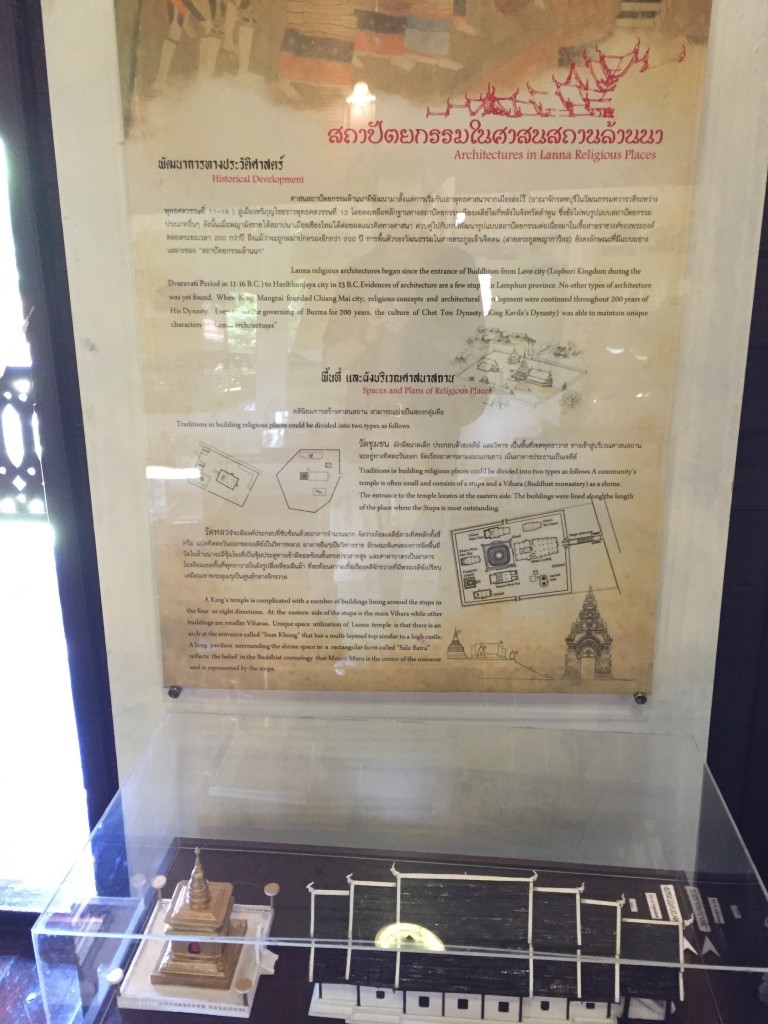
A temple building, and explanation. If you zoom in, you should be able to read the English text. One thing I didn’t see explained: every building model included a little arrow on the ground which seemed to indicate North. This, I presume, would indicate the importance of Feng Shui principles in the building’s layout — the compass direction of entrances and the placement of significant rooms and their contents being very important in that system.
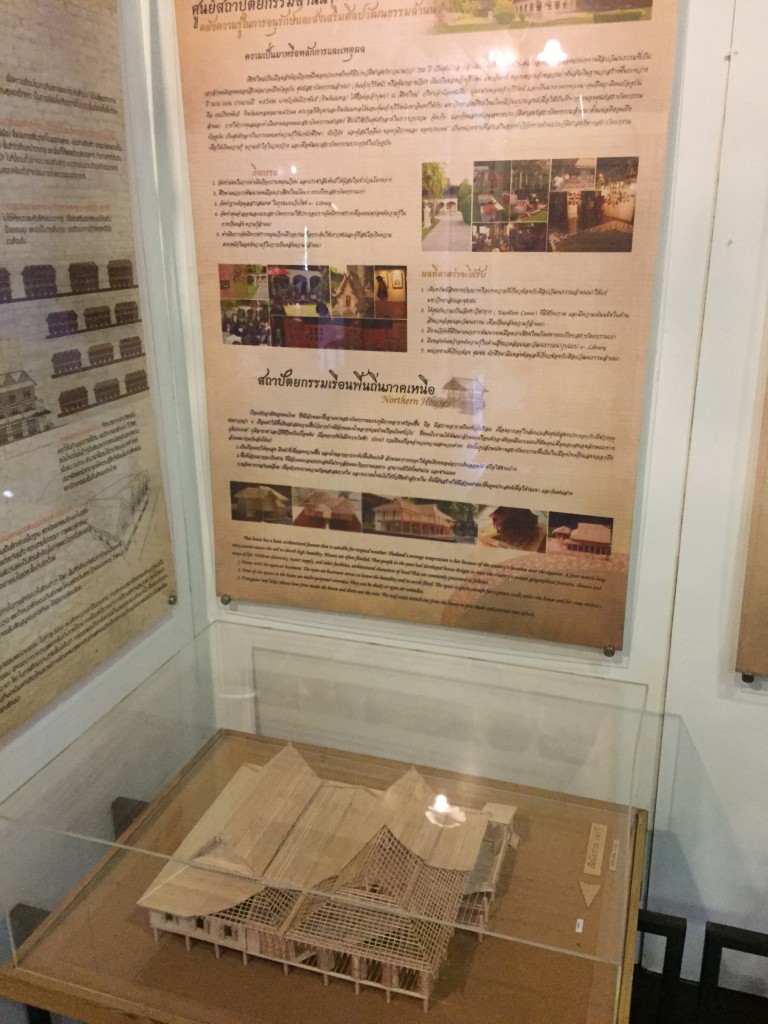
There’s little English on this sign, and what there is is at the bottom and a bit blurry. I’ll transcribe it below.
You never quite know how your iPhone photos will come out, and I pretty much started out this trip not worrying too much about them: they either work or they don’t, but I’m not going to spend forever trying to optimize them. (Especially once I discovered that they usually looked better on a computer than they do on the iPhone itself.) But, looking at the photo above, I notice that the only English text is a bit on the blurry side and, being in a generous mood, I’m going to attempt to render it below and save you all the effort (even assuming that you were all inclined to spend said effort). I think this should be mostly accurate (including the grammatical irregularities):
Thai house has a basic architectural feature that is suitable for tropical weather. Thailand’s average temperature is hot because of the country’s location near the equator. A four month long rainy season causes the soil to absorb high humidity. Houses are often flooded. Thai people in the past had developed house designs to meet the country’s unique geographical features, climate, and way of life. Without electricity, water supply, and other facilities, architectural characters of local Thai are commonly presented as follows.
|
The upper floor of this building had places to sit out on the veranda and just read or talk, and Tony likes to come here to just do that. We didn’t end up going into the ground floor, and it suddenly occurs to me to wonder why I didn’t even peek in. Maybe it was a gift shop? Maybe it was a study space for architecture students? This is what happens when you just follow the herd, and now I will never know. Alas.
From there, we walked east along the main east-west street, Rachadamnoen, where the Sunday Market is held, heading for the Tha Phae Gate. There were a lot of shops and stalls that we passed along that street, and Tony observed that what they were selling had changed with the season. At this time of year the tourists are mostly Chinese — like, around 80% Chinese. Western tourists like to buy souvenirs, like local crafts and such; but the Chinese buy more food, so the local stalls had food and fruit out instead of tchotchkes. And the motorbike store had moved the really big bikes to the front displays, because the Chinese like those more than the light, agile, fuel-efficient ones that Westerners tend to like. It’s an interesting insight into another culture, from the viewpoint of a 3rd party, and weirdly unbiased because the vendors aren’t judging. They only care about what sells, and they adjust accordingly.
We walked through the Tha Phae Gate and about a block east to our lunch spot, Pulcinella da Stefano. Stefano was an Italian guy who’d been in the area a while (I don’t recall how long, but somewhere in the 15-20 year time frame I think). I was going to include a link to their site, but I’m not sure they have one; I’d say they should, but maybe Google is all they need. At any rate, they had a large menu, and a lot of amazing food, mostly Italian or Thai, and a lot of vegan choices. I had a really incredible cannelloni, and something from their drink menu:
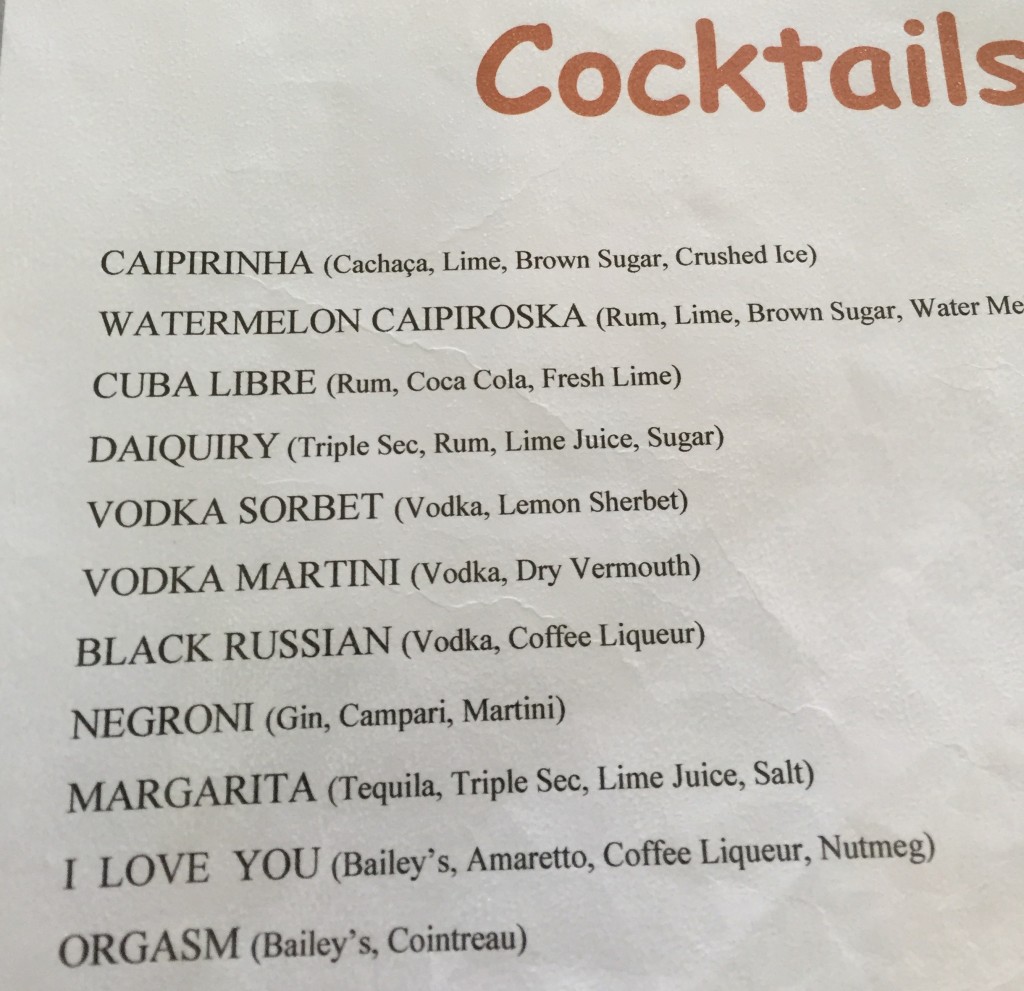
See if you can guess which drink I asked for. I’d offer you a hint, but you don’t really need one, do you?
The owner, Stefano, talked to us while we were ordering, and had a long conversation with our vegans (Mark and Claudia) about vegan dining and what he himself ate (he was vegan, except when he had to taste his restaurant’s non-vegan fare). For his own meals, he ground rice into rice flour to make his own special gluten-free rice pasta, and offered to make their meals with it, which was very generous of him. They reported that it was excellent — although Mark pulled out a bag of ground flax seed that he proceeded to heavily dollop over everything in a way that struck me as more than a little insulting. You don’t get a special meal from the chef and then immediately alter it with your own additives. That’s like sitting at a sushi bar and slathering your custom piece of sushi with wasabi, soy sauce, and ginger. (Jiro Dreams of Taking You Out Back And Putting A Bullet In Your Head.) Stefano struck me as being a bit taken aback by the action, but he didn’t actually say anything and, who knows, maybe I was projecting my own mild shock onto him. Still. Mark, dude, don’t. Just… don’t.
As we left, we started to split up; a couple of us needed to go to a nearby bank, and Tony and David and I needed to go back to our vehicles at our starting park. So, the 3 of us walked to the Loop of Death and Tony hailed a tuk-tuk, and we rode back around the Loop along with a couple of English girls who were trying to get to some location — I vaguely remember it being a music conservatory — but had no real idea of where it was. David talked to them during the ride; I think I overheard that they thought it was outside the northeast corner of the old city, but I didn’t try to mansplain anything, or volunteer Tony to do so, and the three of us exited the tuk-tuk at our stop, left them to their search, and went our own separate ways. I rode my bike over to the large Rimping shop nearby, got groceries, and rode back home — and passed David running across the Loop of Death pretty much where I’d left him 30 minutes before. He didn’t visible recognize me riding by — quite understandable, given that his primary focus would have been on not dying — and he didn’t try to meet my eyes and get my body-language agreement to let him by, so I’m clearly not the only one ignoring Tony’s suggestion.
And that was the tour. The remaining week passed uneventfully in the usual way — Tony had a tour of an elephant park the following Sunday, but I didn’t go to that. I’d meant to research whether this was one of the good parks or not — I’m sure it was, knowing Tony — but I kept forgetting to do that and then it was too late. He hasn’t scheduled another tour since then, but I expect that he will soon.
After the Tour, and Some Miscellaneous Stuff
There were a few odds and ends in my daily life, before and after the tour, that are well worth pointing out.

The view west from my balcony. You can make out the temple at the top of Doi Suthep (where I was in the last blog post). I mention it only because (a) we could see my place from there, and now we’re looking back, and (b) it’s purty.
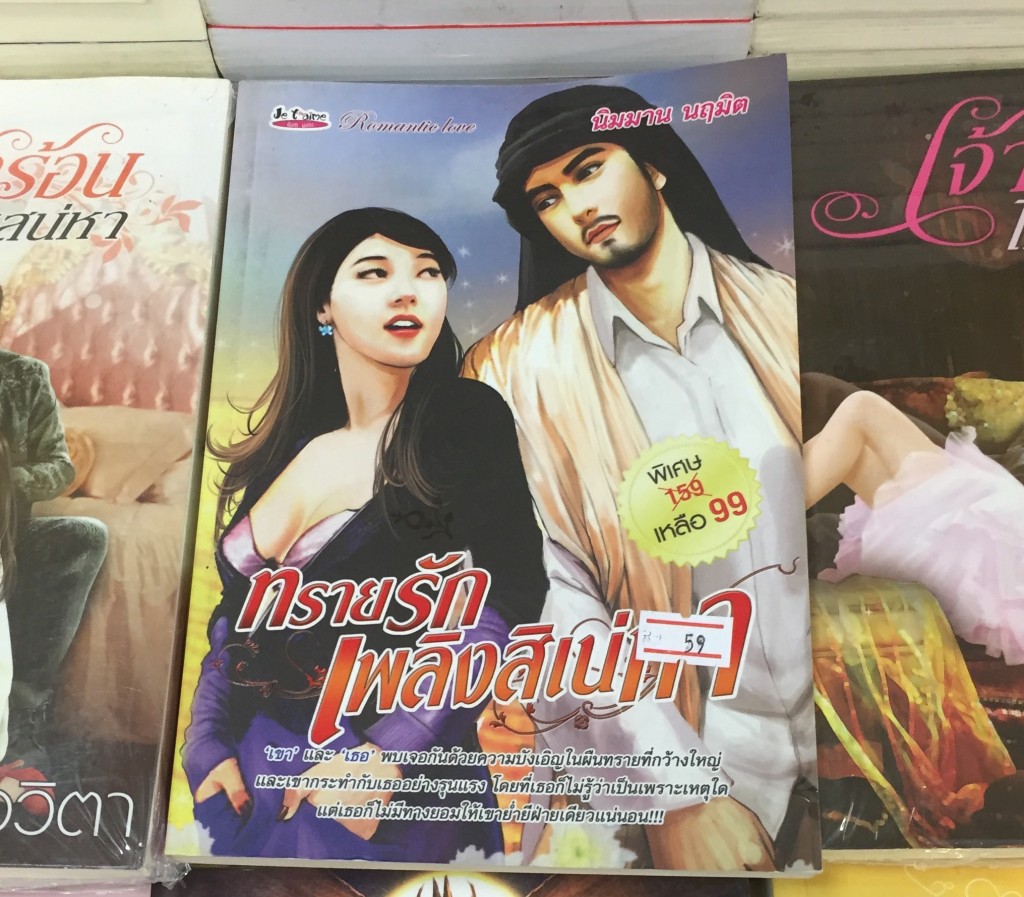
A book stand at the local Weird Creepy Mall (Damien referred to it that way once, and I’ve adopted the name, and now he looks amused whenever I call it that). I can’t read the Thai characters, but it looks like a searing political commentary on the imbalance of power relationships between OPEC and non-oil-producing countries. Probably a very enlightening read.

It’s pretty cool that they make special sandals for people who have lost their toes. Seems like it would be a niche market, but they’ve got it covered.
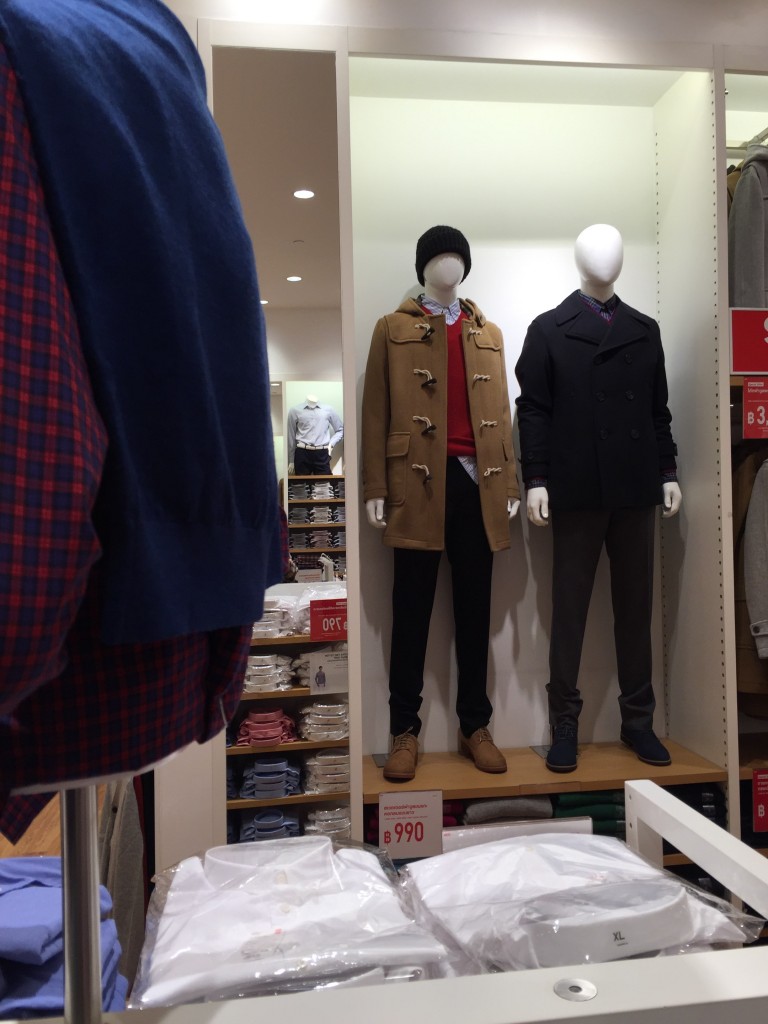
When I was shopping for shoes, I noticed that the stores at the Central Festival Mall were stocking Fall clothing now. Here. In Thailand. Heavy coats. Granted, the last time it was really rainy and overcast, the temperature was a nippy 70°, but these are heavy coats! (Tony says they’re just for people who travel to cooler places. Places that are not Thailand)

I saw this from a distance, and thought the sporting goods shop had a sword department. The closer view yielded nothing but disappointment.
We had some really good weather last week: a couple of days of serious rain, and a couple more that were mostly just cool and overcast, so several days of lovely cool, where I could sit out for brunch at the Larder for a couple of hours and just read and listen to the rain on the awning overhead, or sit inside my room with the balcony door open and no A/C. It was awesome; if Chiang Mai were like this all the time, or even half the time, I might very well stay. But then it turned all bright and sunny again and has mostly been that ever since, so…
However, The Larder in the rain is a fantastic place to sit and read, and so it’s worth mentioning a book that I spent some hours there reading in the rain: Jim Butcher’s brand new book, The Aeronaut’s Windlass. 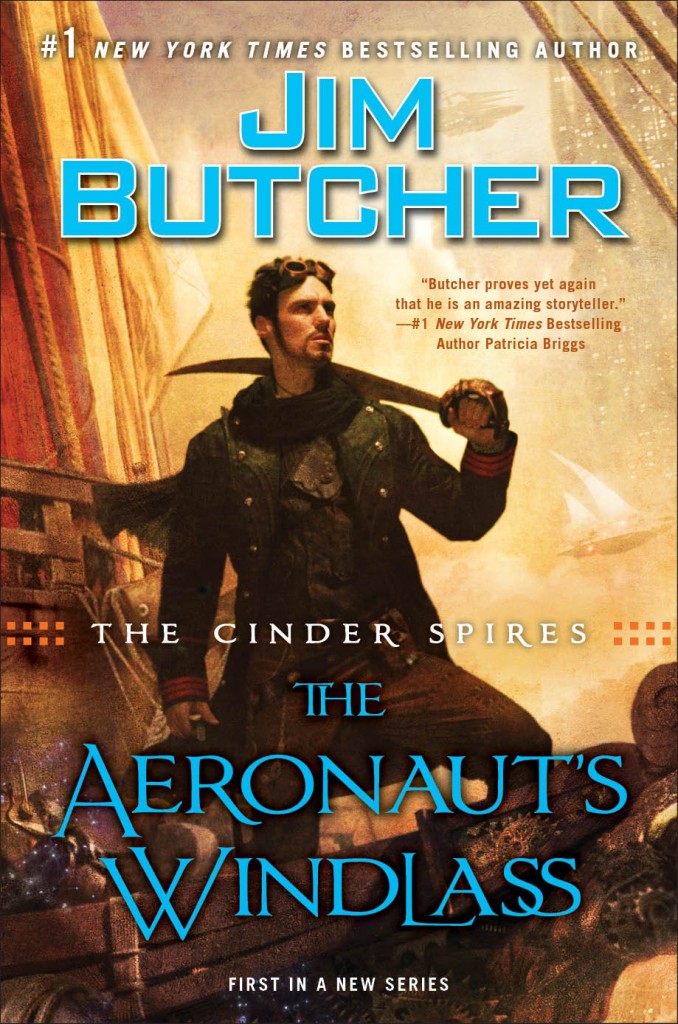
I like everything Jim Butcher writes, and this is the start of his 3rd series (the others being still-running Dresden Files and the completed Codex Alera — both of which are excellent). This was billed in advance as being a steampunk novel — and I guess I can see what would lead people to call it that. There’s the pseudo-technology set in a predominantly wood-and-stone culture that characterizes classical Victorian-setting steampunk. But this isn’t that setting at all: it’s a civilization on some sort of other world, no sign of an English empire in sight. Just giant stone spire city-states rising out of the cloudy atmosphere of a deadly surface world, constructed by the “Builders” in that civilization’s prehistory, and ships that sail the skies between the spires, powered by etheric crystals, and merchant navies and pirates and cutlasses and etheric weapons. And a writing style that pushes Butcher’s normal sarcastic sense of humor into actual whimsy, which I particularly loved in this setting. It’s like he’s visibly playing with the fun of a steampunk-ish setting, and inviting you in on the game.
Butcher doesn’t tell much of the origins of this civilization, he just allows fragmentary, myth-shrouded hints of it to appear in context; I have my suspicions, based on how he’s framed it, but I won’t spoil anything here. I’ll just say that, for my tastes, this was one of the best books I’ve read in a while. The kind of book where you’ve been completely absorbed reading it and you gradually sense that you need to shift position, and as you do so you reflexively look up and suddenly the world reappears around you like someone flicked a light switch, and you realize you’d completely lost awareness of your surroundings. You marvel at that, and then you go back to reading and the world disappears again until the next position shift. I haven’t gotten so completely lost in a book in quite a while. All of you who commonly get such books from me at holidays should expect to see this one at Christmas. (And if you can’t resist ordering it sooner, do let me know.) It’s pretty awesome.
Moving On
As of two days ago, Saturday, October 17th, I moved into where I’ll be living for the second month of my stay here, which is here, a small 3rd floor studio just north of the Maya. I’m not really ready to talk about it yet — it has problematic aspects, and I’ve learned to wait a few days to describe problematic places or else my description is liable to just be the word “Hate!” written over and over again for 3-4 paragraphs. But the Airbnb listing is here, and it’s clean and it’s cheap, so… yaay that.
The Future
In a few days I’ll write the next post, which will be before any new tours so that I can just focus on what’s next. As many of you know, I’ll be Home For The Holidays starting in just under a month! November 17th I fly back to LA; I’m there until a few days after Thanksgiving, then I go north to SF, Seattle, and Bozeman, return to LA in mid-December, head to New York a few days after New Years, and I’m off to Europe after that. I’ve just finished solidifying the Europe plans and booking the first few months of residences, and I’ll report on all of that in the next post. Which will be Soon. No, really, I mean it this time. (He says, holding the football and looking expectantly at you to come kick it.)


